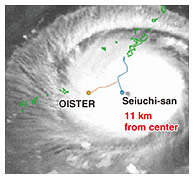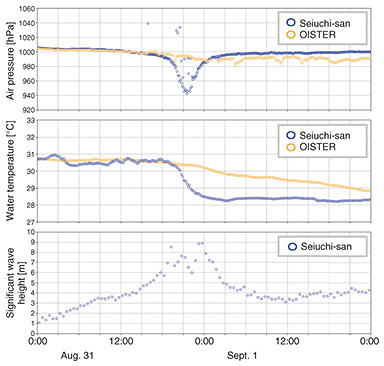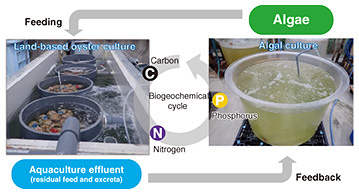 |
|||||||||||||||||||
|
|
|||||||||||||||||||
|
Feature Articles: Efforts in the Environmental and Energy Sector to Create a Sustainable and Resilient Society Vol. 22, No. 3, pp. 64–69, Mar. 2024. https://doi.org/10.53829/ntr202403fa7 Forefront Research Initiatives on Environmental Adaptation to Enhance Societal Resilience to Environmental ChangesAbstractNTT Space Environment and Energy Laboratories aims to create a resilient society that can respond flexibly to environmental changes by predicting patterns in the environment and human activities and developing technologies for environmental adaptation. In this article, we introduce the latest topics of research in cosmic-ray barrier technology and global environmental futures forecasting technology. Keywords: cosmic ray, typhoon forecast, ocean ecosystem 1. IntroductionThe Resilient Environmental Adaptation Research Project at NTT Space Environment and Energy Laboratories has been promoting research toward a resilient society that can respond flexibly to future environmental changes. The resilient society we aim for is a world in which we can adapt to environmental changes. We will not only be able to avoid or forestall the damage to human society caused by natural phenomena but will also be able to take advantage of natural phenomena that have been regarded as scourges. In October 2023, our project welcomed a new research group, the Environment and Socioeconomic Nexus Forecasting Technology Group. Together with this research group, we are working to accelerate research aimed at sustainable prosperity for people and the global environment (comprehensive sustainability), which requires anticipating more long-term and complex events and taking early action. The technological themes we are working on to achieve these goals can be roughly categorized into the following two phases. The first is adapting to environmental changes to enable more proactive measures in advance to be taken in response to extreme natural phenomenon, and the second is predicting future environmental changes for the adaptation by taking into account the mutual effects of the global environment and human activities. With respect to these themes, we introduce the latest research topics in cosmic-ray barrier technology and global environmental futures forecasting technology, respectively. 2. Forefront research initiatives of cosmic-ray barrier technologyThis section introduces findings in cosmic-ray research (solar flares and radiation from galaxies), which is part of our ongoing research aimed at environmental adaptation to avoid or lessen damage caused by natural phenomena. Sophisticated electronic devices support our lives in numerous ways, but they increasingly fall victim to soft errors caused by cosmic rays. When cosmic rays, which rain down from space, collide with oxygen or nitrogen atoms in the atmosphere, neutrons are generated. When neutrons collide with a semiconductor in an electronic device, they can cause soft errors, a phenomenon in which the data stored in a semiconductor are changed. Soft errors have the potential to negatively impact social infrastructures, such as telecommunication failures (Fig. 1). In considering measures against soft errors in electronic devices, it is important that the system design takes into account the frequency of the soft-error-induced failures of each device. The frequency of soft-error-induced failures varies greatly depending on the energy of neutrons reaching the device. Therefore, it is critical to clarify the energy dependence of the soft-error rate (SER)*1 (SER at different neutron energies).
NTT Space Environment and Energy Laboratories and Hokkaido University have joined forces and successfully measured the semiconductor SER at continuously varying neutron energies in the low energy range of 10 meV (milli-electron volt) to 1 MeV (mega-electron volt), a range which has not been previously measured [1]. The findings revealed a complete picture of the neutron energy dependence of semiconductor soft errors in conjunction with our measurements in the high-energy region, which were successful in 2020 (joint research between Hokkaido University, Nagoya University, and NTT) (Fig. 2). Taking countermeasures against soft errors is essential for electronic devices that support our current social infrastructure. Clarifying the SER for different neutron energies is of utmost importance for studying such countermeasures since the SER varies greatly depending on neutron energy.
We measured soft errors caused by low-energy neutrons below 1 MeV using the time-of-flight method with a high-speed soft-error detector developed in 2020. The time-of-flight method is a means of calculating the neutron speed and converting it to kinetic energy by measuring the time taken for the neutron to travel a certain distance. The experiment was conducted by connecting a high-speed soft-error detector developed by NTT to the instrument for neutron source characterization (neutron beamline for observation and research use (NOBORU)) installed at the Materials and Life Science Experimental Facility of the Japan Proton Accelerator Research Complex (J-PARC) (J-PARC Proposal No. 2022A0249). The intensity of neutrons used for irradiation at this facility was evaluated by Hokkaido University using the gold foil activation method*2. The SER in a field-programmable gate array (FPGA)*3 was measured for continuously varying energies with high resolution. The data show that the SER tends to be lowest around 0.1 MeV but increases as the energy decreases. We assume that this is due to boron (boron 10), which is present in trace amounts in semiconductors. Among the low-energy neutrons, we determined that the SER is higher with neutrons in the energy band around 25 meV (2.5 x 10–8 MeV), known as thermal neutrons*4. These thermal neutrons are produced when high-energy neutrons enter hydrogen-containing materials, such as water, plastics, and electronic substrates, and lose their speed. Therefore, their number varies greatly depending on the surrounding environment (Fig. 3). For example, if semiconductors are cooled by water, the thermal neutron count is expected to increase significantly. Thus, the data obtained in this study will make it possible to simulate the number of failures caused by soft errors, taking into account the surrounding environments of electronic devices, and to take measures appropriate for this energy region.
With the data obtained in this study, we have clarified the characteristics of the occurrence rates of soft errors caused by low-energy neutrons in cosmic rays. The findings make it possible to more accurately calculate the rate of failures caused by soft errors, which is the key to evaluating soft errors and studying countermeasures. Soft errors have the potential to cause malfunctions in all electronic devices that contain semiconductors. Evaluating soft errors and countermeasures against them is crucial to a variety of industries and business fields, from current information and communication technology equipment and transportation infrastructure to artificial intelligence-based automatic control and smart factories, which are expected to become more ubiquitous. Going forward, we hope to contribute to the construction of a safer and more secure social infrastructure by simulating the number of failures caused by soft errors, taking into account the surrounding environments of electronic devices, and by studying soft-error countermeasures appropriate for low-energy regions. In due course, we will apply the results of our research to countermeasures in space against cosmic rays, thereby contributing to constructing the Space Integrated Computing Network [2], and the advancement of humankind in space.
3. Recent trends in global environmental futures forecasting technologyTo improve societal resilience, global environmental futures forecasting technology is needed to predict and adapt to the changing environment as well as to restore the environment, which has been impacted by human activities [3]. Such technology is used to model and simulate physical phenomena, such as climate and weather, as well as biological and chemical phenomena, such as ecosystems and carbon cycles, on the basis of global-scale observations. Through highly accurate prediction of extreme weather events, such as typhoons and linear precipitation zones, as well as changes in marine ecosystems caused by human activities in conjunction with climate change, more proactive response measures can be taken. The following sections introduce the progress in typhoon observation toward improving the accuracy of typhoon forecasting and marine ecosystem circulation forecasting technology toward clarifying the path to restore the environment. 4. Progress in typhoon observation for improving forecasting accuracyTyphoons, which can have a major impact on society, have been intensifying in strength and causing more damage as a result of global warming and other consequences of climate change. To prepare for typhoons more effectively, it is important to accurately predict the strength of typhoons at landfall as early as possible. However, typhoon forecasts based on the analysis of satellite images are limited in accuracy. In 2021, in collaboration with the Okinawa Institute of Science and Technology (OIST), NTT began observing the area directly beneath typhoons, which cannot be observed by satellite, using a wave glider. In the summer of 2022, we successfully conducted the world’s first simultaneous marine and atmospheric measurements at multiple locations in the northwest Pacific Ocean directly beneath a Category 5 typhoon, which is the strongest class typhoon, before it reached land [4]. In this experiment, Seiuchi-san, NTT’s autonomous wave glider for atmospheric and ocean observations, came as close as 11 km from the center of the typhoon (Fig. 4) and was able to capture rapid changes in pressure in the storm area (top of Fig. 5). Compared with OIST’s OISTER, Seiuchi-san measured a rapid decrease in sea-water temperature (approx. 2°C) closer to the center of the typhoon (middle of Fig. 5). Seiuchi-san also measured a maximum wave height of approximately 9 m (bottom of Fig. 5), providing information on the interaction between the atmosphere and ocean directly under the typhoon, which had not been available from satellite observations.
In 2022, we started a joint research project with the Typhoon Science and Technology Research Center (TRC) of Yokohama National University, a research institute in Japan specializing in typhoon research, to improve the accuracy of typhoon forecasting [5]. We will continue to progress typhoon observation for real-time typhoon data collection and aim to improve the accuracy of typhoon forecasting by using the acquired atmospheric and oceanographic observation data and incorporating them into the TRC’s typhoon forecasting model. 5. Progress of marine ecosystem circulation forecasting technologyThe marine ecosystem circulation forecasting technology models the food chain and material cycle processes of marine ecosystems and predicts the impact of human activities on marine ecosystems in addition to the effects of climate change [2]. This technology contributes to the maintenance of ecosystem services such as the protection of fisheries resources and carbon dioxide fixation. As a first step, we developed an ecosystem model for closed-cycle land-based aquaculture to predict changes in the ecosystem. We first hypothesized the impact of human activities on marine ecosystems on the effluent from closed-cycle land-based oyster aquaculture. We then developed a material circulation process model for oyster aquaculture, considering the simple food chain between oysters and phytoplankton, which is their diet. Closed-cycle land-based aquaculture is a method of aquaculture carried out in a closed space on land without contact with rivers or the ocean. The water quality is maintained by removing food and excreted waste while circulating the water. In addition to oysters, phytoplankton (algae) are produced in the land-based oyster farm targeted in this study, and wastewater from the oyster tank is used to cultivate the algae, thus achieving completely closed land-based aquaculture without wastewater. Oyster cultivation is not simply a matter of increasing the amount of phytoplankton. Undigested feed left by oysters can lead to water contamination, which affects oyster growth. For efficient recirculation in land-based aquaculture, it is important to determine the balance of circulation, including the optimal amount of oyster excreta and feed, which can be done by predictive simulation. We developed a model for predicting changes in phytoplankton levels in recirculating land-based oyster aquaculture (Fig. 6). The model was also used to predict phytoplankton production from wastewater discharged from oyster aquaculture.
In the future, we will extend the model and the knowledge obtained and apply it to modeling ecosystems in coastal areas where human activities have a large and complex impact as well as in open ocean areas that are expected to be increasingly used in the future. We aim to develop a forecasting technology for marine-ecosystem cycles that will help to restore the ecosystems. References
|
|||||||||||||||||||


















